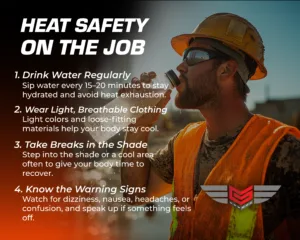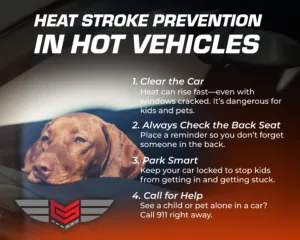With rising temperatures, the risk of heat-related illnesses, particularly heat stroke, also increases. Heat Stroke Awareness Month serves as a critical reminder to educate ourselves about the dangers of extreme heat exposure. This condition can escalate quickly, leading to severe health complications if not addressed promptly. Recognizing the signs of heat stroke, implementing preventive measures in vehicles, and staying safe during extreme heat events are essential steps in creating a safer environment for everyone.
May 1st is also National Heatstroke Prevention Day, which emphasizes the need for education on heatstroke prevention and the dangers of hot cars. Both observances play a crucial role in promoting heat awareness and ensuring public safety.
 Recognizing the Signs of Heat Stroke
Recognizing the Signs of Heat Stroke
Heat stroke is a severe condition resulting from the body overheating, often due to prolonged exposure to high temperatures. Recognizing common symptoms in both adults and children is crucial. These symptoms include a high body temperature (above 103°F), altered mental state or confusion, rapid heart rate, nausea, and loss of consciousness. In children, signs like excessive fussiness, lethargy, or a lack of sweating despite the heat are important to note.
It’s vital to differentiate between heat exhaustion and heat stroke, as they represent different levels of heat-related illness. Heat exhaustion typically involves heavy sweating, weakness, dizziness, and a body temperature below 103°F. If not addressed, heat exhaustion can progress to heat stroke, which is a medical emergency.
Knowing when to seek medical attention is critical. If someone exhibits signs of heat stroke, such as a high body temperature, confusion, or loss of consciousness, call emergency services immediately. Prompt intervention can prevent serious complications and save lives. Always stay hydrated and take necessary precautions during hot weather to reduce the risk of heat-related illnesses.
Preventing Heat Stroke in Vehicles
As temperatures rise, heat stroke awareness becomes crucial, particularly regarding the safety of children and pets in vehicles. Understanding the dangers of hot cars and the importance of never leaving anyone unattended in a parked vehicle is essential. Even on mild days, the temperature inside a hot car can skyrocket within minutes, leading to life-threatening situations. Parents and pet owners must always remember that a few moments of forgetfulness can have dire consequences.
Before entering your vehicle, check the interior temperature by feeling the steering wheel or dashboard. If it feels excessively warm, let the vehicle cool down before getting in. Opening the windows can help lower the temperature inside. Being proactive about vehicle temperatures is a simple yet effective way to prevent heat-related incidents.
Leveraging technology can enhance safety measures. Many modern vehicles come equipped with reminders to check for passengers in the back seat. These alerts can prevent tragic oversights. If your vehicle lacks such technology, consider using smartphone apps designed to remind you to check for children or pets before locking up. These tools ensure everyone arrives safely at your destination, making heat stroke awareness a shared responsibility.
May’s observances encourage everyone to stay vigilant and adopt preventive measures. Understanding the dangers of hot cars and being proactive can save lives and prevent heat-related tragedies.
Staying Safe During Extreme Heat
As temperatures soar during Heat Stroke Awareness Month, prioritizing safety and well-being is crucial. Hydration is your first line of defense against heat-related illnesses. Drink plenty of water throughout the day, especially before and after outdoor activities. Carry a reusable water bottle to stay hydrated, and consume electrolyte-rich beverages if engaging in strenuous activities.
When participating in outdoor activities in hot weather, timing is everything. Schedule workouts or leisure activities for the early morning or late evening when temperatures are cooler. Wearing loose-fitting, light-colored clothing can also help your body stay cool. Always take breaks in shaded or air-conditioned areas to allow your body to recover from the heat.
Creating a cool environment at home and in vehicles is essential for comfort and safety. Use fans and air conditioning to maintain a comfortable indoor temperature, and keep blinds or curtains drawn during peak sunlight hours. In your vehicle, never leave children or pets unattended, as temperatures can rise dangerously high in minutes. If your vehicle lacks air conditioning, use sunshades or park in shaded areas to keep it cooler. By taking these precautions, you can enjoy the summer while minimizing the risks associated with extreme heat.
During Heat Stroke Awareness Month, it’s crucial to implement these strategies and stay informed. National Heatstroke Prevention Day reinforces the importance of these practices, ensuring public safety during heat awareness month.
